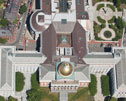Most experienced building owners and facility managers agree maintaining buildings' components and systems is necessary to optimize and extend buildings' functional lives. However, in some instances carrying out proper roof system maintenance is overlooked.
To maximize roof system life, NRCA recommends preventative maintenance for roof systems; NRCA also provides sources for additional useful information regarding roof system maintenance and repairs.
Preventative maintenance
Preventative maintenance is intended to enable building owners and facility managers to proactively identify and implement solutions to roof system problems before problems become more widespread. In most instances, if roofing-related problems are identified early and properly repaired, the problem's extent and cost of necessary repairs will be significantly less than if the problem were left unattended.
NRCA recommends building owners and facility managers schedule roof system maintenance inspections at least biannually, preferably in spring and fall. Additional inspections are suggested after any severe weather events, such as a hurricane, tornado or hailstorm.
A preventative roof system maintenance inspection typically involves a thorough visual inspection of the roof system and its adjacent surfaces (such as walls), as well as any mechanical equipment that can affect the roof system's watertightness. Conditions should be documented in writing and photographed, and the documentation should be filed. The file can provide a basis for comparing changing conditions during subsequent inspections.
During an inspection, any debris or other materials that do not specifically belong on the roof should be removed.
If an inspection reveals repairs are necessary, routine repairs sometimes can be carried out immediately. If immediate repairs cannot easily be made, they should be made as soon as possible to avoid further roof system deterioration.
Roof system inspections can be conducted by building personnel who have general knowledge of the roof system and follow proper safety procedures.
If a building owner does not have personnel who can perform inspections, a professional roofing contractor should be retained. NRCA recommends a professional roofing contractor perform any repairs beyond what would be considered owners' maintenance responsibilities. Examples of owners' maintenance responsibilities include removing any accumulated debris from the rooftop and trimming any tree branches that overhang the roof.
If a roof system is covered by either a contractor's or manufacturer's warranty, NRCA suggests the roofing contractor who installed the roof system perform any repairs to avoid possible conflicts with warranty requirements.
Additional useful information
NRCA has developed several documents and manuals that may be useful when implementing roof system preventative maintenance programs.
NRCA's Consumer Advisory Bulletins, "Maintenance: The Key to Long-term Roof Performance" and "Roof warranties," are one-page documents intended to encourage building owners and facility managers to conduct roof system maintenance.
In addition, NRCA publishes roof system-specific guidelines for building owners and managers for conducting preventative maintenance inspections and routine repairs. The publications specifically address built-up and polymer-modified bitumen, single-ply membrane, architectural metal panel, structural metal panel and spray polyurethane foam roof systems.
And NRCA's Repair Manual for Low-slope Membrane Roof Systems provides instructions for performing common repairs on built-up, polymer-modified bitumen and single-ply membrane roof systems.
Whether you use NRCA's maintenance publications, develop your own company maintenance publications and programs, or use some other means, I encourage you to promote maintenance to your building owner and facility manager clients.
Mark S. Graham is NRCA's associate executive director of technical services.



